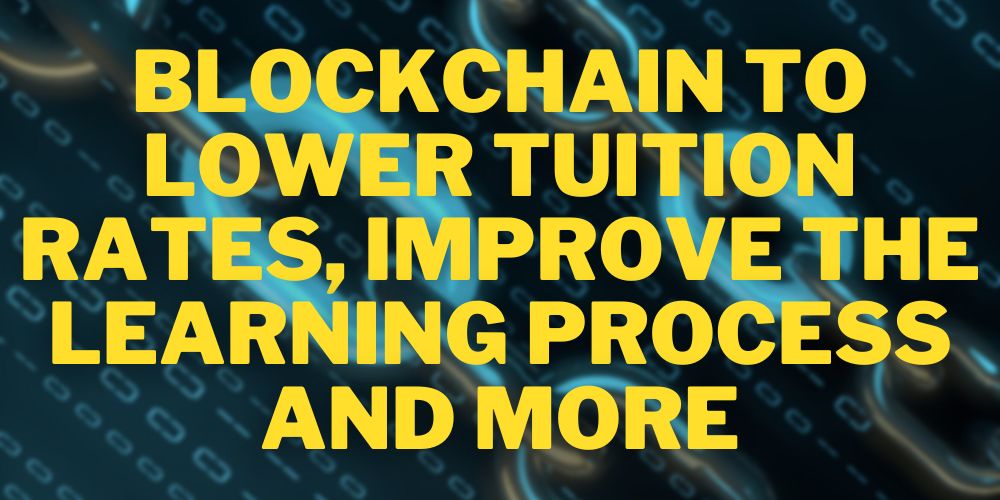According to a 2019 Gartner survey, only 2% of higher education institutions were using blockchain at that time, with another 18% planning to do so over the next two years. Universities currently widely utilise this technology to share and store academic data and certificates. Yet, despite blockchain’s potential, scalability and costs prevent blockchain’s adoption and use in the educational system.
The term “blockchain” was not widely used until a few years ago. Yet, today, it is widely heard of and used interchangeably with cryptocurrency.

Does it have other applications besides finance? Yes, it does. And the reason it can and most likely will impact dozens of industries is because it uses a secure decentralised ledger and can protect and organise data.
Due to the pandemic, the education industry quickly adapted to digitalisation. Blockchain technology can be beneficial for this industry and has the potential to profoundly transform how teachers and students cooperate and handle academic data.
Let’s look at how blockchain can impact learning, teaching and education for the next generation.
Blockchain’s Impact on Education
Higher education aims to pass on information to future generations of students and expand current knowledge via research.
Professors dedicate a significant amount of their time to doing original research and publishing their results, pushing the boundaries of their professions.
Blockchain may help them and students be more effective in learning and sharing. Here’s how:
– Courses and lessons. Many blockchains support smart contracts, and, as a result, lectures and seminars may be encoded into the blockchain and completed automatically when specific criteria are met. For example, a teacher may delegate tasks to students, and smart contracts on the blockchain might automatically check that each mission was accomplished. After all duties are completed, students may be granted credits, and teachers may be compensated in crypto tokens.
– Students’ records. Some of the most time-consuming tasks at universities and institutions are to issue transcripts, update grades, and secure the way students access their records. Blockchain technology can ease this labour-intensive activity, as it is all about security and encryption.
– Fees. Tuition payments are inconvenient and time-consuming for parents, government organisations, and pretty much anyone involved in the process. Some practices may be eased by using blockchain, possibly leading to minimised tuition rates.
– Diplomas and degrees. Universities or colleges can dispose of the traditional certificate, save students’ data on a blockchain and remove the need for employers to verify documents.
– Access. Blockchain may allow everyone to access free educational resources like online courses, podcasts, books, etc.

Barriers to Blockchain Adoption
Barriers to using digital coins in the educational system come from the fact that this technology is not regulated or backed by financial institutions, and it’s not familiar to as many professors, parents, and students as it should be.
Yet, it’s best to know what virtual currencies are and how to buy cryptocurrency.
The world is evolving at a rapid rate, so you might want to be up-to-date with the economic trends or, why not, expand your investment portfolio with cryptocurrency.
Hopefully, as updates are made on the blockchain, the trend will appeal to more people, and ways to effectively and advantageously include it in customers’ and users’ day-to-day tasks will emerge.
However, despite the apparent benefits, educational institutions have been slow to embrace blockchain technology. Their reluctance stems from obstacles like the following:
– Legacy. Legacy solutions are among the most significant impediments to using blockchain technology because many academic institutions are yet to get rid of offline document management systems. More understanding of blockchain technology’s numerous benefits, particularly its interoperability, is required to propel the transition to a decentralised solution.
– Scalability. Scalability is one of the critical reasons blockchain cannot be applied to such a complex sector as education. The blockchain grows slower as more data blocks are added because analysing all of the data histories takes time. Although distributed ledger technology has recently gained new means of enhancing transaction speeds, many potential blockchain users would rather stay on familiar ground.
– High expenses. Blockchain technology’s high initial costs are slowing its education adoption rate. Because decision-makers in the education sector lack sufficient awareness of blockchain technology’s numerous advantages, they feel the required expenses may exceed the benefits.
Metaverse and Education
The Metaverse is a digital or virtual platform where users can create virtual settings. It also serves as a virtual meeting place for people from all around the world.
Users can connect to a virtual area and chat in real time using their web browser or virtual reality headset.
Metaverse worlds will most likely play a significant role in the future of education because they’re a reproduction of the real world that can be tailored to the designer’s preferences.

Teachers might make lessons more interesting by creating a distinctive, entertaining setting and possibly even relevant to the topic pupils are learning about.
If you thought Zoom connections were useful, the Metaverse goes a step further by offering communication possibilities with stunning graphics and animations.
You may interact with colleagues, co-workers, family, and friends in ways that are probably hard to imagine with 100% accuracy.
Remember the movies Inception, Tron, and The Matrix? In the sphere of education, this is called AR (augmented reality), which helps to overlay information and pictures on top of the real environment.
AR uses signals from sensors and gadgets to display relevant information and assist you in interacting. This is how the Metaverse can enable you to have virtual experiences that feel like real life.
Final Words
Technology has the potential to profoundly disrupt and change the education industry by having the following impacts:
– Improved data security and trust
– Automated record storage and sharing
– Lifetime student ownership of records
– Accelerated recruitment processes.
Blockchain adoption can improve the effectiveness of the academic ecosystem and resource usage. To reap the benefits described above, educational systems must address issues like scalability, cryptocurrency research, blockchain implementation expenses, etc.
To make blockchain use worth the effort and money, it’s safe to say that the population and governors need to accommodate the trend and be more open and cooperative towards a future-ready education system.


 Tags:
Tags:










